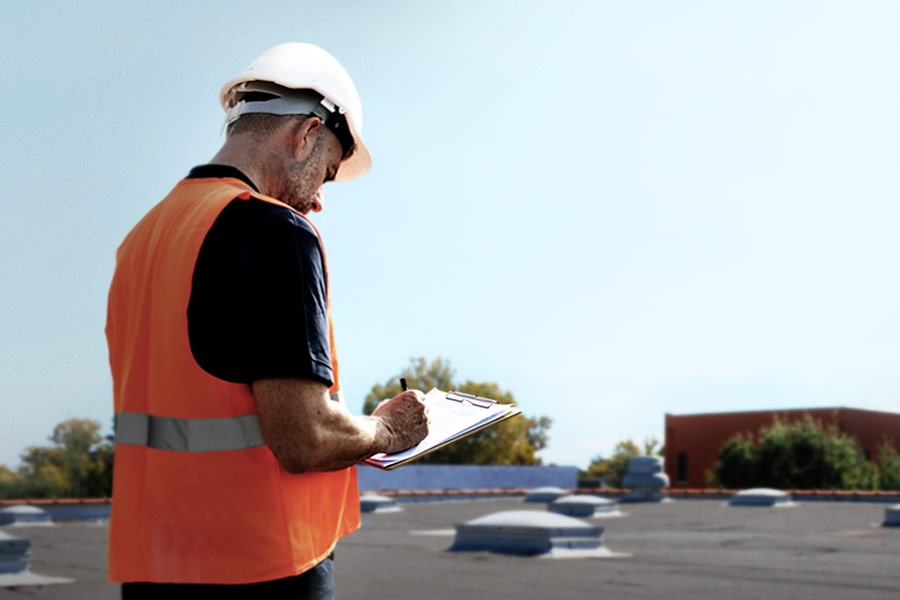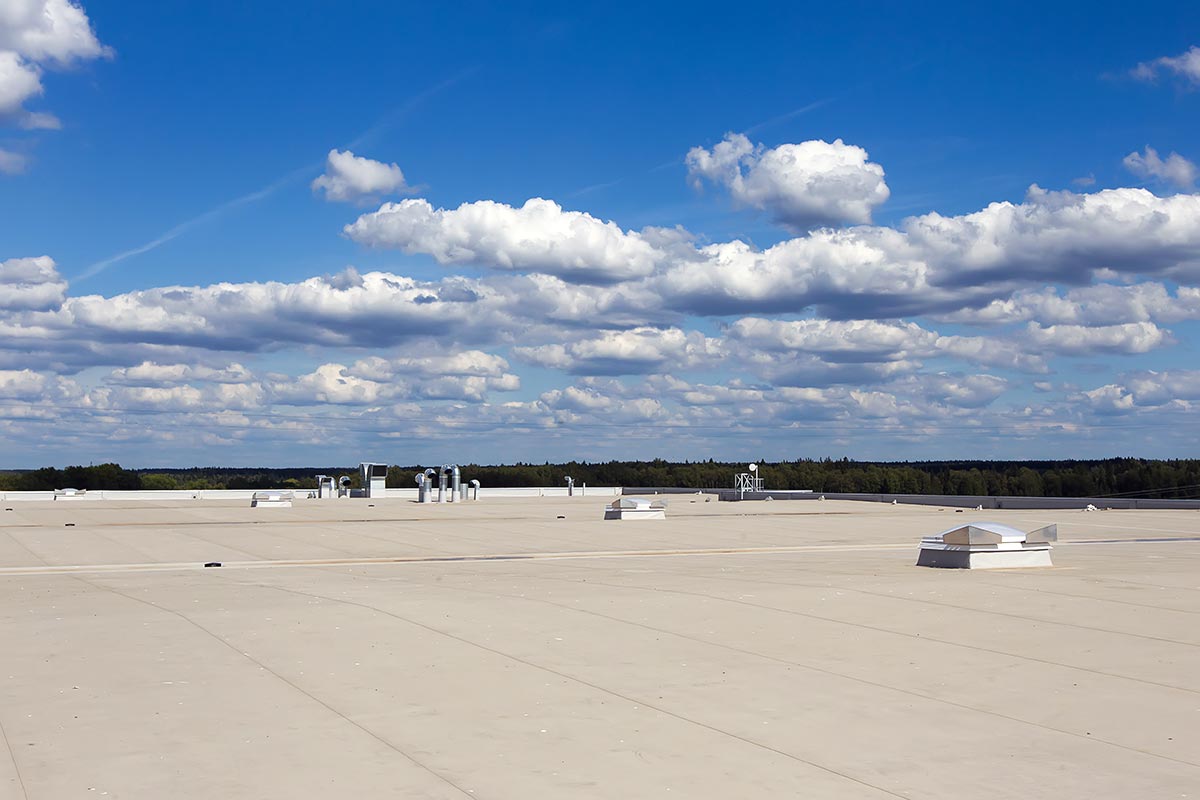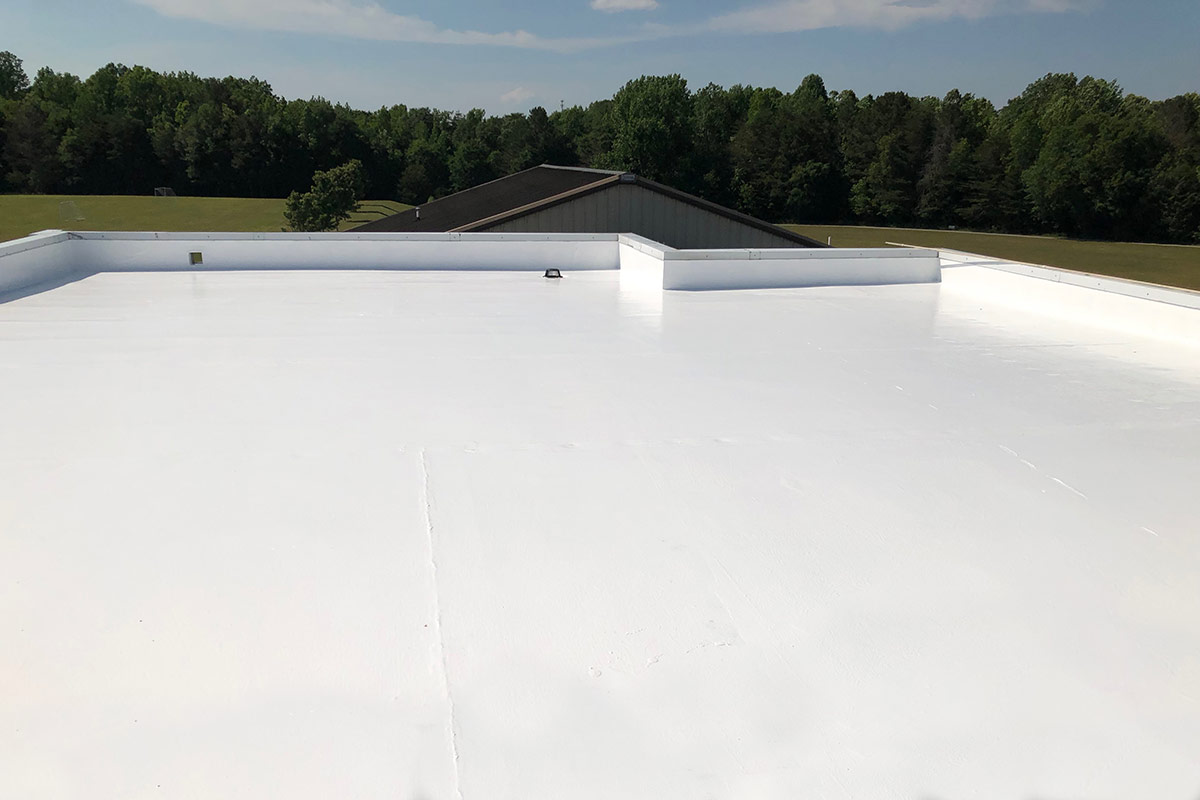
Generally speaking, flat roofs offer many advantages. They’re cost-effective, easily accessible, relatively easy to install, and even energy efficient in some cases. They also provide an ideal location for various building components such as HVAC units, solar panels, and communication equipment.
Flat roofs aren’t without problems, though. The same characteristics that make flat roofs so effective can quickly turn into vulnerabilities if not properly maintained. To get the most out of your flat roof, let’s take a closer look at ten of the most common flat roof problems:
1. Exposure
Exposure is essentially the root of all flat roof problems. That’s why it’s #1 on our list. Since a building’s roof is constantly exposed to the sun and other elements, damage from the outside world is inevitable. No roofing material, no matter how durable, can last forever.
Common flat roof issues include over-exposure to the sun, lightning strikes, freezing, hail, and wind damage or wind-driven debris. There are even less common exposure issues such as oil damage in restaurants or exposure from outside pollutants and chemicals.
2. Leaks
Leaks are an all-too-common occurrence in buildings with flat roofs. This is mostly because flat roofs tend to lose their ability to effectively shed water if not properly maintained. Once moisture is unable to drain from the roof, it’s just a matter of time before it finds its way into the building.
Though roof leaks may seem harmless enough, they can lead to much bigger problems down the road if not addressed promptly and accordingly.
3. Ponding Water
Inherently, flat roofs don’t always provide the proper drainage for precipitation to run-off. Most flat roofs are constructed with a slight slope in order to allow for said drainage, but the lack of a natural slope can sometimes create problems. As a result, the water from precipitation collects in standing ponds on the roof. The weight of the ponding water will eventually cause the roof to sag and could even become a leak.
4. Punctures/Splits/Tears
Flat roofs are prone to punctures or tears from storm damage. This is why commercial roof inspections are especially important after a major weather event has occurred. Pedestrian foot traffic can also cause punctures, but restoration systems that incorporate proper walk paths can help avoid this problem.
5. Structural Movement
Structural movement, or thermal movement, is the natural expansion and contraction of a building’s envelope based on temperature. This is a completely natural occurrence that can lead to movement in the roofing assembly as well as the entire building structure.
Commercial buildings are especially prone to thermal movement when indoor cooling makes the interior temperature of the building much different than the outside temperature. This excess movement causes flat roof membranes to crack and split around penetrations, seams, and other flashing details.
6. Debris
Debris on a roof is any loose material or refuse such as leaves, tree limbs, dirt/mud, dust, or even trash from human presence. Any roof will have a small amount of debris on it at any given time due to natural wear-and-tear and exposure to the elements, but too much debris build-up can potentially clog drains and cause irreparable damage—especially on flat roofs that lack a natural slope for drainage.
To ensure a flat roof drains correctly (or to ensure that a fluid-applied restoration system can be installed properly), debris can be removed by pick up, leaf-blowing, or pressure-washing.
7. Biological Growth
Growth can form in any stagnant body of water—an unattended swimming pool with no circulation of water, for example. When ponding water on a flat roof is stagnant for long periods of time, vegetation and algae can form. A dirty roof will be less reflective and ultimately impact both the interior and exterior temperatures of the building. Regular cleaning is a must for roofs at risk of ponding water and signs of biological growth should be monitored during a commercial roof inspection.
8. Blistering
Blistering and other surface defects, such as “alligatoring,” are very common on flat roofs. Alligatoring refers to a flat roof membrane that has deteriorated to the point that it literally looks like alligator skin (pictured above). Most surface defects are usually caused by over-exposure to the sun or saturated insulation.
9. Shrinkage
Shrinkage occurs on flat roofs made from synthetic rubber membranes, such as EPDM (a common type of flat roof material). It causes seams to delaminate and pull apart eventually allowing small openings to form in the roof surface.
Though EPDM is a popular choice in the construction of flat roofs due to its durability, all EPDM roofs will eventually experience shrinkage. Natural shrinkage can also be inadvertently accelerated by errors in the manufacturing or installation of the roof membrane.
10. Neglecting Maintenance
Perhaps the single biggest cause of premature roof failure is forgetting to perform routine maintenance. All of the above-mentioned flat roof problems are easily preventable with a routine maintenance plan and commercial roof inspections. Furthermore, they can be resolved with the application of a fluid-applied roof restoration system.
Conclusion
If your flat roof constantly leaks or suffers from any of the other problems mentioned above, schedule a free roof inspection with an American WeatherStar Approved Contractor as soon as possible. Should you choose to restore your flat roof with a fluid-applied roof restoration system, the Approved Contractor can also provide you a free quote.
Related Posts
In Need of a Commercial Roof Inspection?
Perhaps you’ve noticed leaks in your building or unsightly brown stains on the ceilings and interior walls. Whatever the case may be, these…
Flat Roof Materials—Which Perform Best?
Flat roofs are very common. The vast majority of commercial and industrial facilities around the world have a flat roof. So it’s not surprising…
What Is the Best Flat Roof Coating?
When it comes to selecting a flat roof coating, there’s an abundance of potential solutions out there. In order to choose the best roof coating…











